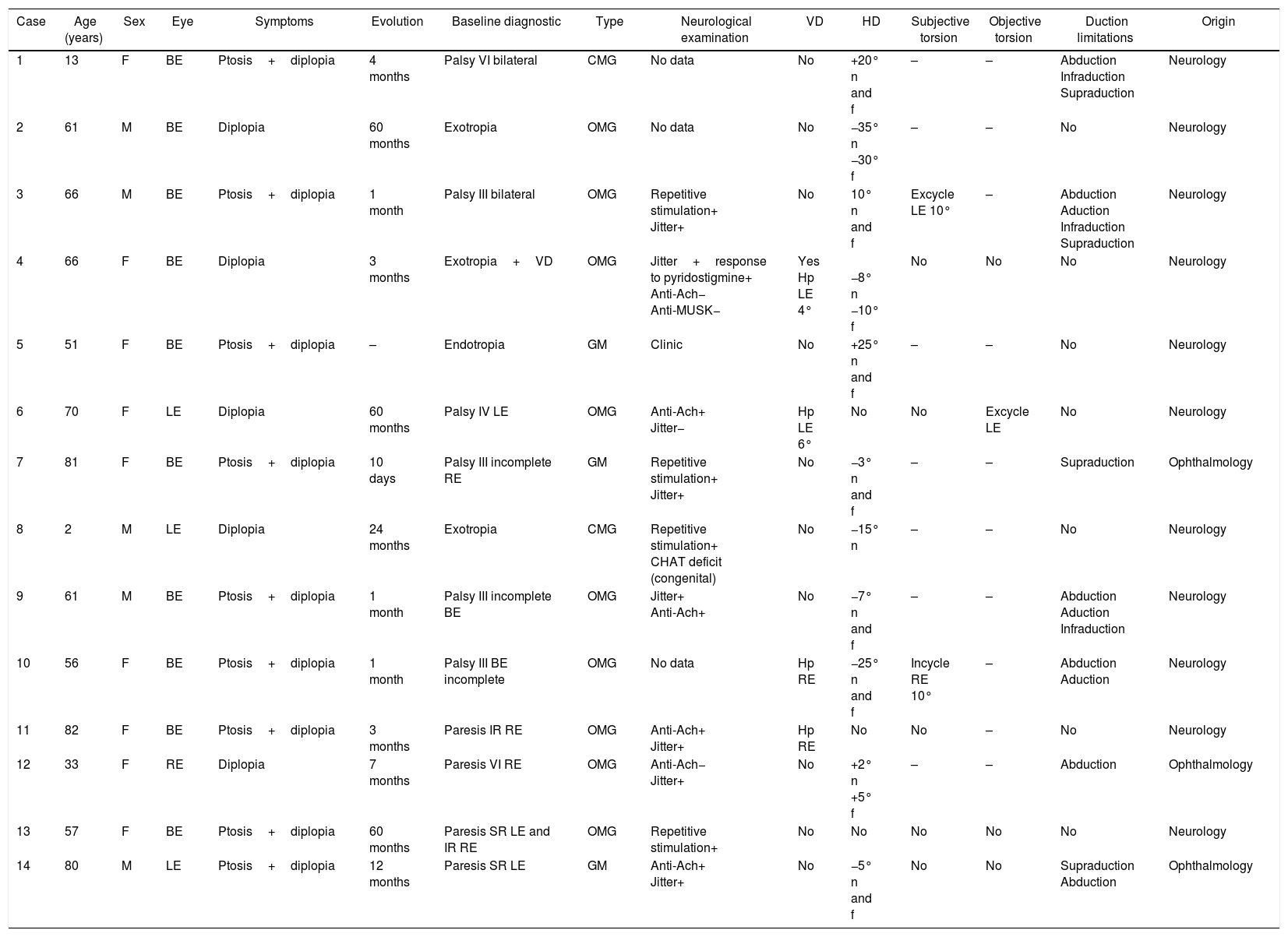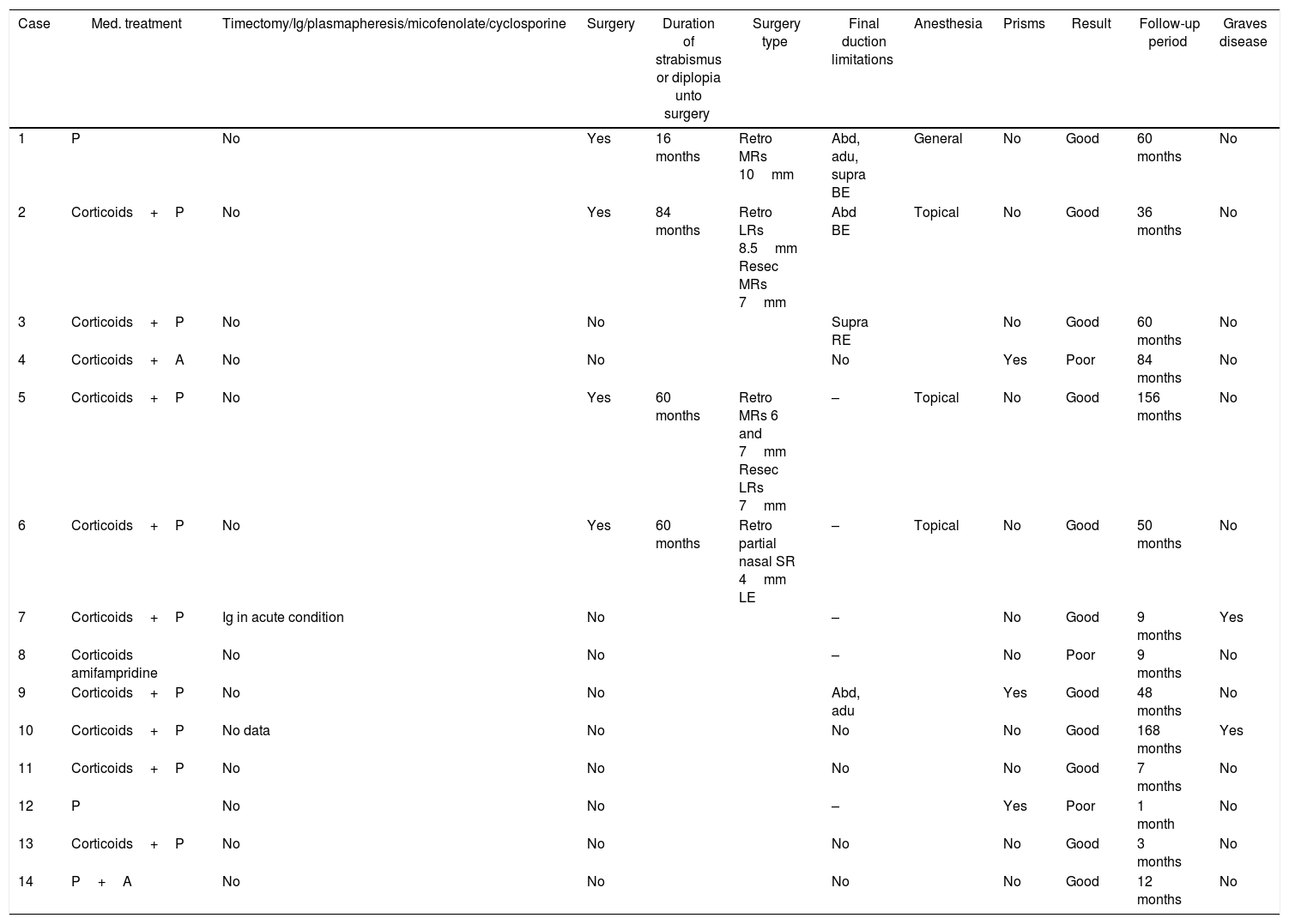To present a report of the ocular motility disorders, treatment and outcomes of myasthenia gravis (MG).
Material and methodA retrospective study was performed on the data of patients with MG. An evaluation was made using mean age, gender, initial diagnosis, ocular deviation, time of onset of clinical characteristics, treatment and results. Resolution of diplopia and/or ocular deviation in primary and reading gaze was considered a good outcome at the end of follow-up.
ResultsA total of 14 cases were included. The mean age of the sample was 55.64 years, of which 9 were women, and 10 cases were bilateral. The diagnosis was made by ophthalmologists in 4 cases. The initial diagnoses were diverse: bilateral cranial third nerve palsy in 3, unilateral third nerve palsy in 1, superior or inferior rectus palsy in 3, sixth nerve palsy in 2, fourth nerve palsy in 1, exotropia in 3 and esotropia in 1. Diplopia was presented in 14 cases and 9 associated ptosis. The different types of strabismus were horizontal ocular deviation in 11 cases: 8 with exotropia, and 4 with vertical deviation. Strabismus surgery was performed in 4 cases that did not respond to medical treatment, with a good final outcome. Pharmacological treatment resolved diplopia in 6 cases, and prisms in one. Ptosis surgery was only necessary in one patient. Outcome was favorable in 78.57% at the end of follow-up.
ConclusionAcute onset diplopia caused by strabismus with variable angle or oculomotor palsy, associated or not with a ptosis can indicate MG. There were favorable outcomes with strabismus surgery. Pharmacological treatment did not resolve the diplopia in all cases.
Describir las alteraciones de la motilidad ocular, tratamiento y resultados en la miastenia gravis (MG).
Material y métodoSe analizaron retrospectivamente datos de pacientes con MG. Se evaluaron la edad media, el sexo, el diagnóstico inicial, la desviación ocular, la evolución de los síntomas, el tratamiento realizado y los resultados. Se consideró buen resultado la resolución de la desviación o diplopía al final del seguimiento en posición primaria de mirada y lectura.
ResultadosSe incluyeron 14 casos (9: mujeres; bilaterales: 10) de edad media: 55,64 años. En 4 el diagnóstico fue realizado en oftalmología. El diagnóstico inicial fue en 3 casos parálisis del iii par bilateral, en uno parálisis del iii par unilateral, en 3 paresia de recto superior o inferior, en 2 casos parálisis del vi par, en uno paresia del iv par, en 3 de exotropía y en uno de endotropía. La diplopía se presentó en los 14 casos y 9 asociaron ptosis. La desviación ocular fue horizontal en 11 (8: exotropía) y vertical en 4. Se realizó cirugía de estrabismo con buen resultado final en 4 casos que no respondieron al tratamiento farmacológico. Seis pacientes resolvieron la diplopía con el tratamiento farmacológico y un caso con prismas. La ptosis requirió tratamiento quirúrgico en un paciente. Se consiguieron buenos resultados en un 78,57%.
ConclusiónLa diplopía de comienzo agudo secundaria a un estrabismo de ángulo variable o parálisis oculomotora, con o sin ptosis, puede ser diagnóstico de MG. La cirugía de estrabismo consiguió buenos resultados. El tratamiento farmacológico no consiguió resolver la diplopía en todos los casos.
Artículo
Comprando el artículo el PDF del mismo podrá ser descargado
Precio 19,34 €
Comprar ahora








